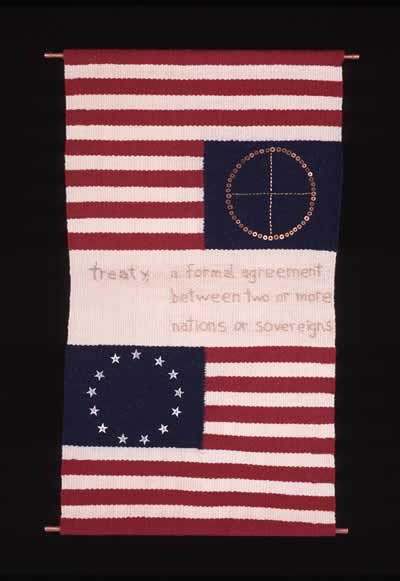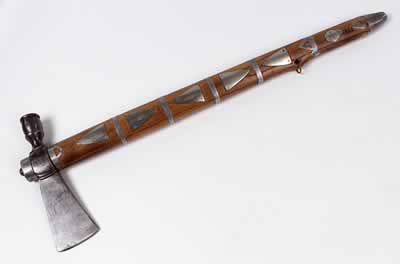|
|
Canku Ota |
|
|
(Many Paths) |
||
|
An Online Newsletter Celebrating Native America |
||
|
June 15, 2002 - Issue 63 |
||
|
|
||
|
Indiana is Still Mihtohseenionki |
||
|
Our Thanks to the Eiteljorg
Museum
|
||
|
credits: Photographs courtesy of the Eiteljorg Museum |
|
Eiteljorg Museum tells
a familiar story from an unfamiliar - but more balanced - viewpoint
That conversation with his grandfather started 25-year-old Miami Nation of Indiana member Scott Shoemaker down a path toward reclaiming a part of his family's Native American heritage. And that story, which needed to be told, illustrates why the Eiteljorg Museum of American Indians and Western Art in Indianapolis has created a gallery devoted to telling the story of the Native peoples of the Midwest. The Eiteljorg Museum has always involved members of the cultural groups about which the museum has presented exhibitions, said John Vanausdall, president and CEO. "But when we decided to begin exploring how to reinstall our Native American galleries and present them in a way that included the Native American perspective, we knew we had to do more," he said. A Native American Council of members from across the country generally advises the museum. In 2000, the Eiteljorg formed a Native American Regional Advisory Group, made up of Native Americans from the Indiana Woodlands region. This area includes the Miami, Delaware and Potawatomi. Museum staff targeted these tribes in recruiting individuals for the advisory group, focusing on the tribes that were or still are in the area now known as Indiana. Regional Advisory Group members are Scott Shoemaker (Miami Nation of Indiana) of Chicago; Carolyn Knauff (Miami Nation of Indiana) of Denver, Ind.; John Warren (Pokagon Band of Potawatomi Indians) of Bremen, Ind.; and Don Secondine (Delaware) of Archibald, Ohio. Daryl Baldwin (Miami Nation) of West Lafayette, Ind., is a consultant to the Mihtohseenionki project. Baldwin is a linguist specializing in his tribal language and is director of the Myaamia Project at Miami University. Shoemaker, a graduate of Ball State University, works as a landscape architect with Wolff Clements and Associates Ltd. of Chicago. Knauff is a member of the Miami Nation of Indiana tribal council and also sits on the tribe's cultural traditions committee. Warren is the former cultural program director of the Pokagon Band Community Development Office in Dowagiac, Mich. He is a teacher with a strong background in Potawatomi history, specifically the Pokagon Band. Secondine runs the trading post and is gunsmith and silversmith at Sauder Village in Archibold, Ohio. He also works with Conner Prairie and its Lenape Indian camp and has been a presenter and demonstrator at the Eiteljorg Museum's Harvest Celebration and Indian Market. "These individuals have immersed themselves in the development our new gallery, Mihtohseenionki (The People's Place), giving generously of their time, talents and resources," Vanausdall said. "Much of the success that comes from this gallery, we owe to them." Much of the success also is owed to the Native American artists who agreed to share their work and traditions with museum visitors. For example:
"There are many subtle messages that will emerge from the installation," wrote Daryl Baldwin (Miami). "One message in particular touches on modern efforts to restore, and in some cases reclaim, traditional languages and cultures through the use of modern technology .... Another positive attribute is the demonstration component of the installation. Allowing Native American artist and crafts people to come into the exhibit area and share one on one with the public will only serve to strengthen the living aspect of Native Americans today. ... Tying the physical past with the physical present sends a powerful message that Native People are still a living, thriving, yet ever-changing People." According to John Vanausdall, the Eiteljorg's president and CEO, this is a brand-new approach for the museum. "Part of our mission is to inspire an understanding of the art, culture and history of the indigenous peoples of North America," Vanausdall said. "We can't do this by presenting artifacts alone. With this new gallery, our visitors will walk away with an understanding of how Native peoples used to live and how they continue to live today. In this way, we hope to enhance everyone's appreciation of and even their basic knowledge about the contributions made to our world today by Native Americans." Two historic events
for the price of one: Mihtohseenionki and the 10th Anniversary Indian
Market
Two of the most visible pieces of art surrounding these congruent events will be an icon we see now more than ever before: the American flag. "According to Webster..." by Marty Gradolf, a Winnebago of Nebraska who lives in Nashville, Ind., is a weaving of two flags joined by a white space that carries the Webster's Dictionary definition of "treaty" ("treaty; a formal agreement between two or more nations or sovereigns"). The flag at the top bears a Native American medicine wheel on the blue ground. The flag at the bottom bears 13 stars, marking the time of the start of treaties between the United States and Native peoples. This flag is upside down, a universal symbol of distress. "The Native American flag portion is not really an 'official' Native American flag," Gradolf said. "The Medicine Wheel is recognized as a Native American image representing the four directions and the people of the four directions. I used Webster's definition of treaty as a thought-provoking bridge between the two flags." Gradolf completed this piece in February 2001, seven months before Sept.11. Her affection for the work hasn't changed in the aftermath of the attacks. "I created this because I've always been intrigued by flags - what they say, who they represent and how they look. Historically, it is interesting to me how the American flag has been portrayed," she said. "The message is timeless." During the Indian Market, Gradolf's flag will become part of the Mihtohseenionki gallery, alongside another flag that probably was created by another female Native American - one from 200 years ago. The Anthony Wayne flag was made by Miami women using the ribbonwork technique they used to decorate clothing. Overlapped ribbons create the design. 10th Anniversary Indian
Market immerses visitors in art and culture
In February, 126 Native American artists were accepted into the Indian Market. They come from all over the country and represent more than 50 tribes. To be accepted, applicants must be documented members of a federally or state-recognized tribe, and their work must be of the highest quality. All work brought by the artist must be handmade by him or her in the past two years and cannot include any part of a protected species of animal. "This protects our visitors, who want to buy art that is well made and is authentically Native American," said Ray Gonyea, the Eiteljorg's curator of Native American art and culture. "As a museum, our reputation among Native American artists is growing each year, because they know we present only the best." The Eiteljorg Museum Indian Market Presented by SBC Ameritech has three main components: a juried arts competition with cash prizes, an opportunity for sales between artists and the public (the museum doesn't take a commission), and the sharing of Native American culture through craftspeople, traders, storytellers, singers, dancers and food experts. All the artwork is for sale, and prices range from $30 to thousands. The work includes handmade jewelry, blankets, paintings, sculptures, clothing, pottery, weavings, quillwork, drawings, prints, pipes and drums. Where a particular tribal group or artistic medium is underrepresented among the artists, the Eiteljorg invites Native American traders to present the work of several artists. But as many visitors come for the cultural experience as for the artwork. "The experience allows you to get a taste of Native American cultures from across the country, literally and figuratively," Gonyea said. Here's what's in store for the 10th Anniversary Indian Market:
This year, to mark the significance of the 10th anniversary of the Indian Market and the opening of Mihtohseenionki (The People's Place), Native Americans from the region will conduct a traditional ceremony that the public is invited to watch. This ceremony will take place at noon on Saturday, June 22, and is free; it will be on the front lawn of the Eiteljorg Museum (at the corner of West and Washington streets downtown), rather than on the Indian Market grounds. The Eiteljorg Museum 10th Anniversary Indian Market is presented by SBC Ameritech. Additional sponsorship by the Coca-Cola Bottling Co., Central Indiana Trane Dealers, Native Peoples magazine, RTV-6, Emmis Communications, and the Chubb Group of Insurance Companies. Marsh Supermarkets is the official ticket outlet. 10th Anniversary Eiteljorg
Museum Indian Market Indian Market:
Location: Parking: Cost: Information and
advance tickets: Preview Party
sales event and silent auction: First opportunity to purchase art!
|
|||||||||||||||||||
|
|
||
|
|
||
| Canku Ota is a free Newsletter celebrating Native America, its traditions and accomplishments . We do not provide subscriber or visitor names to anyone. Some articles presented in Canku Ota may contain copyright material. We have received appropriate permissions for republishing any articles. Material appearing here is distributed without profit or monetary gain to those who have expressed an interest. This is in accordance with Title 17 U.S.C. section 107. | ||
|
Canku Ota is a copyright © 2000, 2001, 2002 of Vicki Lockard and Paul Barry. |
||
|
|
|
|
|
The "Canku Ota - A Newsletter Celebrating Native America" web site and its design is the |
||
|
Copyright © 1999, 2000, 2001, 2002 of Paul C. Barry. |
||
|
All Rights Reserved. |
||




